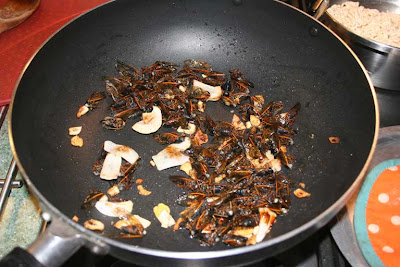 |
| Tomatoes are grafted when quite small. Notice the grafting clips. |
Grafted Tomatoes
In recent years heirloom tomatoes varieties have made a big comeback. The buying public has grown increasingly weary of store-bought tomatoes which have no flavor. More gardeners have turned to growing heirloom tomatoes, which have outstanding tomato flavor. But many heirloom tomatoes are prone to virus problems (which is one of the reasons tomatoes were hybridized, to avoid some of the disease problems).
 |
| Heirloom tomatoes have the best flavor in taste-tests. |
According to several garden forums and blogs, the top-rated tomato for flavor is the ‘Brandywine,’ followed by ‘Cherokee Purple’ ‘Sun Gold’ and ‘Beefmaster.’ Of course, each gardener has their own tastes and preferences.
Log House Plants in Cottage Grove, OR has been testing grafted tomatoes for several years, attaching such varieties as ‘Big Beef,’ ‘Brandywine’ and ‘Sun Gold’ to the roots of reliably stronger, disease resistant root stock. Their testing has shown an average of 30% increased tomato production, without the disease problems.
In their growing trials, Log House Plants planted grafted and non-grafted tomatoes of the same varieties side by side, in exactly the same growing conditions. The results were dramatic. The grafteds produced larger, healthier plants with more pounds of tomatoes per plant than the non-grafted ones. Additionally, near the end of the season when the non-grafted tomatoes had ceased producing, the grated tomatoes continued producing fruit right up to frost.
 |
| A grafted tomato that is well established, the graft is between my fingers. |
Grafting tomatoes isn’t new, it’s been done commercially in New Zealand and Japan for many years. What is new is growers, like Territorial Seed, are making the grafted tomatoes available to home gardeners. There’s considerable labor involved in the grafting process, making the tomato plants more expensive, but tests have shown the stronger plants and longer production make it a good investment.
 |
| Field trials side by side of grafted and non-grafted tomatoes. |
I visited a certified organic commercial farm in central Missouri recently where friends grow for both farmers markets and Whole Foods stores. They are conducting their own trials with grafted tomatoes to see if the claims about production yields are true. They’ve planted 4,000 non-grafted tomatoes, beside 2,000 grafted ones and are keeping detailed records. If the grafted tomatoes live up to their reputation, these folks will move to using all grafted tomatoes next season.
 |
| Lonnie and a flat of grafted tomatoes, ready for planting. |
What’s this mean for us little gardeners? It means if you like the flavor of heirloom tomatoes but are tired of the virus problems that often come with them, you may want to consider ordering some grafted tomatoes next year. I’ll be reporting more about my own small trials with Territorial Seed grafted tomatoes, along with the trials of the friends who have the 2,000 grafted tomatoes. Territorial Seed offers a variety of grafted tomato varieties by mail. Happy gardening!






